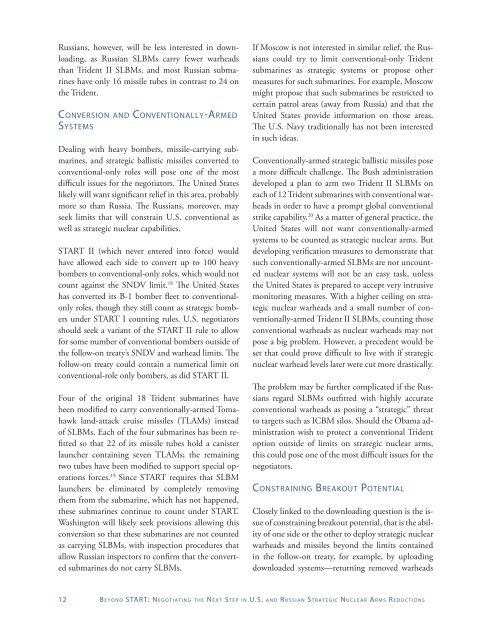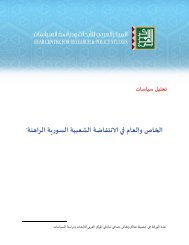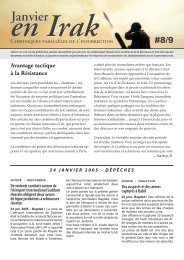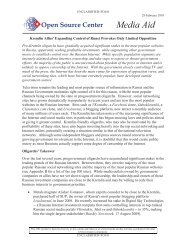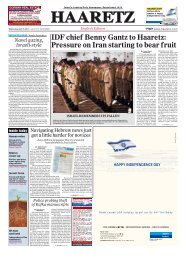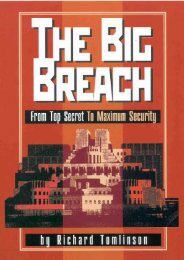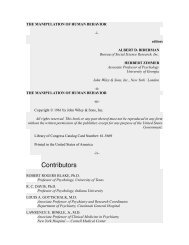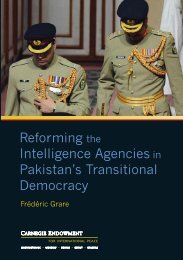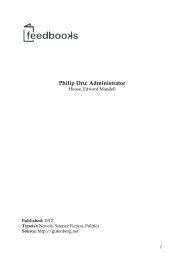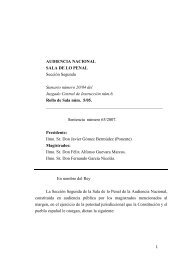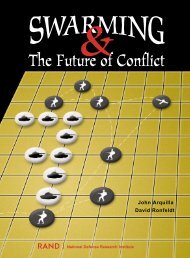Beyond START - Brookings Institution
Beyond START - Brookings Institution
Beyond START - Brookings Institution
Create successful ePaper yourself
Turn your PDF publications into a flip-book with our unique Google optimized e-Paper software.
Russians, however, will be less interested in downloading,as Russian SLBMs carry fewer warheadsthan Trident II SLBMs, and most Russian submarineshave only 16 missile tubes in contrast to 24 onthe Trident.Conversion and Conventionally-ArmedSystemsDealing with heavy bombers, missile-carrying submarines,and strategic ballistic missiles converted toconventional-only roles will pose one of the mostdifficult issues for the negotiators. The United Stateslikely will want significant relief in this area, probablymore so than Russia. The Russians, moreover, mayseek limits that will constrain U.S. conventional aswell as strategic nuclear capabilities.<strong>START</strong> II (which never entered into force) wouldhave allowed each side to convert up to 100 heavybombers to conventional-only roles, which would notcount against the SNDV limit. 18 The United Stateshas converted its B-1 bomber fleet to conventionalonlyroles, though they still count as strategic bombersunder <strong>START</strong> I counting rules. U.S. negotiatorsshould seek a variant of the <strong>START</strong> II rule to allowfor some number of conventional bombers outside ofthe follow-on treaty’s SNDV and warhead limits. Thefollow-on treaty could contain a numerical limit onconventional-role only bombers, as did <strong>START</strong> II.Four of the original 18 Trident submarines havebeen modified to carry conventionally-armed Tomahawkland-attack cruise missiles (TLAMs) insteadof SLBMs. Each of the four submarines has been refittedso that 22 of its missile tubes hold a canisterlauncher containing seven TLAMs; the remainingtwo tubes have been modified to support special operationsforces. 19 Since <strong>START</strong> requires that SLBMlaunchers be eliminated by completely removingthem from the submarine, which has not happened,these submarines continue to count under <strong>START</strong>.Washington will likely seek provisions allowing thisconversion so that these submarines are not countedas carrying SLBMs, with inspection procedures thatallow Russian inspectors to confirm that the convertedsubmarines do not carry SLBMs.If Moscow is not interested in similar relief, the Russianscould try to limit conventional-only Tridentsubmarines as strategic systems or propose othermeasures for such submarines. For example, Moscowmight propose that such submarines be restricted tocertain patrol areas (away from Russia) and that theUnited States provide information on those areas.The U.S. Navy traditionally has not been interestedin such ideas.Conventionally-armed strategic ballistic missiles posea more difficult challenge. The Bush administrationdeveloped a plan to arm two Trident II SLBMs oneach of 12 Trident submarines with conventional warheadsin order to have a prompt global conventionalstrike capability. 20 As a matter of general practice, theUnited States will not want conventionally-armedsystems to be counted as strategic nuclear arms. Butdeveloping verification measures to demonstrate thatsuch conventionally-armed SLBMs are not uncountednuclear systems will not be an easy task, unlessthe United States is prepared to accept very intrusivemonitoring measures. With a higher ceiling on strategicnuclear warheads and a small number of conventionally-armedTrident II SLBMs, counting thoseconventional warheads as nuclear warheads may notpose a big problem. However, a precedent would beset that could prove difficult to live with if strategicnuclear warhead levels later were cut more drastically.The problem may be further complicated if the Russiansregard SLBMs outfitted with highly accurateconventional warheads as posing a “strategic” threatto targets such as ICBM silos. Should the Obama administrationwish to protect a conventional Tridentoption outside of limits on strategic nuclear arms,this could pose one of the most difficult issues for thenegotiators.Constraining Breakout PotentialClosely linked to the downloading question is the issueof constraining breakout potential, that is the abilityof one side or the other to deploy strategic nuclearwarheads and missiles beyond the limits containedin the follow-on treaty, for example, by uploadingdownloaded systems—returning removed warheads12 B e y o n d <strong>START</strong>: Negotiating the Nex t Step in U.S. and Russian Strategic Nuclear Arms Reduc t i o n s


